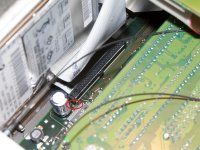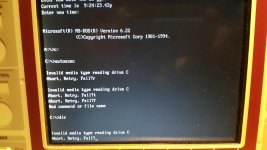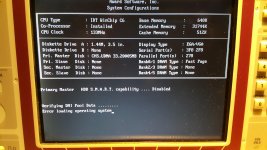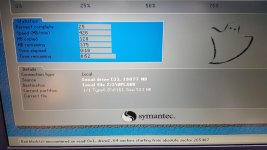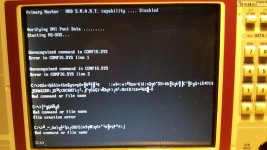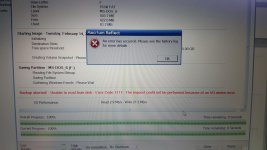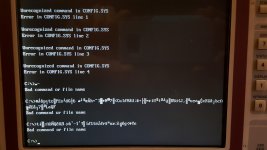Yes, overall, it's not too bad. But the UPL software cannot be obtained anywhere, so should the HDD fail without a backup, the only option is to pay an enormous amount of money to have R&S calibrate it and repair it. $3,970 is their quote. They refuse to provide their software to customers directly due to licensing issues.
It's a really great piece of gear, but there are many things that can go wrong, and those 30 or so relays under the unit are a concern. Should one of them become a little flaky, it would be a nightmare to track it down.
The UPL sports a 44-pin IDE interface for the HDD. R&S used mostly Fujitsu brand HDD at the time for many of their instruments but they did develop a bit of a spotty reputation. I backed mine up to an industrial SLC SSD which just fits into the very limited space and appears to work well.
The UPL sports a 44-pin IDE interface for the HDD. R&S used mostly Fujitsu brand HDD at the time for many of their instruments but they did develop a bit of a spotty reputation. I backed mine up to an industrial SLC SSD which just fits into the very limited space and appears to work well.
I ordered this for the HDD backup:
Inateck USB 3 0 Hard Drive Adapter Converter DVD 2 5 3 5 5 25 034 SATA IDE SDD HDD | eBay
That should allow me to connect this drive to another to clone the contents.
There is an INSTALL directory on the system drive. It appears to have a copy of the install disk there. 16 files total, LZH archives and some bat and doc files. Perhaps that, along with the setups and cal files is all that's needed to start with a new disk? I've sneaker-netted those files to a Windows PC for safe keeping.
I ordered this for the HDD backup:
Inateck USB 3 0 Hard Drive Adapter Converter DVD 2 5 3 5 5 25 034 SATA IDE SDD HDD | eBay
That should allow me to connect this drive to another to clone the contents.
There is an INSTALL directory on the system drive. It appears to have a copy of the install disk there. 16 files total, LZH archives and some bat and doc files. Perhaps that, along with the setups and cal files is all that's needed to start with a new disk? I've sneaker-netted those files to a Windows PC for safe keeping.
It's a tighter squeeze than what may appear since the IDE header is oriented in such a way that depending on what replacement drive you use (PATA vs SATA+adapter), you may find fitting it in a challenge. Also, please note the red circle around the Pin 44 marking. There is no socket to orient the cable so this would be important.
Good luck.
Attachments
I don't see any other option than to unplug the drive and remove the screws holding it in place and do the cloning outboard. Am I missing an easier way?
Taking the HDD out to clone is not a big deal. Just be careful of the metal edges inside since the space is tight and some edges are pretty sharp.
Does anyone have any idea why a cloned drive of the same model as the UPL drive produces a DISC BOOT FAILURE when swapped in for the original drive?
This happened two different times. The first was with building a new system disk. I did this by connecting my bare drive to an Inotek adapter on a Lenovo laptop and using disc mananger in Windows 7 to delete the 20GB partition and re create a 2GB partition that DOS could format. I formated it with a bootable DOS disc "format C: /S". Then I copied the rest of the UPL files to it.
That disc would not boot.
Second attempt was by doing an exact clone with Norton Ghost 2003. I copied the UPL drive to an image file on a 4GB USB thumb drive. Then I replaced the UPL drive with the blank Fujitsu 2020 drive and wrote the image back to this drive, overwriting the original partition made with DOS 6.22 earlier.
This disc would not boot either.
I've never seen a system that could discern a cloned drive as not valid before. Is there no way to make a PERFECT clone of the drive such that the UPL will not think it's a fake and issue a disc boot failure?
This happened two different times. The first was with building a new system disk. I did this by connecting my bare drive to an Inotek adapter on a Lenovo laptop and using disc mananger in Windows 7 to delete the 20GB partition and re create a 2GB partition that DOS could format. I formated it with a bootable DOS disc "format C: /S". Then I copied the rest of the UPL files to it.
That disc would not boot.
Second attempt was by doing an exact clone with Norton Ghost 2003. I copied the UPL drive to an image file on a 4GB USB thumb drive. Then I replaced the UPL drive with the blank Fujitsu 2020 drive and wrote the image back to this drive, overwriting the original partition made with DOS 6.22 earlier.
This disc would not boot either.
I've never seen a system that could discern a cloned drive as not valid before. Is there no way to make a PERFECT clone of the drive such that the UPL will not think it's a fake and issue a disc boot failure?
Part of the mystery is solved:
The disc was invalid media to the UPL and that turned out to be due to the software used to partition the drive.
I re partitioned the drive from a DOS boot disc and was able to get the UPL to boot to a C: prompt.
However, once I restored the Norton Ghost image of the original drive to this new Fujitsu 2020AT (same model as original), the UPL seemed to corrupt all the data, or the data appeared as gibberish.
See attached screen shots, showing the various stages of progress.
Note that Norton Ghost found bad blocks on the original UPL drive. When I showed these on computer forum full of DOS experts, I was told that this looks like software copy protection. "a number of tricks , some involving hiding data in clusters marked as bad, etc." and "that locked itself to the installation HD using (I presume) the HD's serial number."
After cloning the drive, sector by sector, I have a copy that is unreadable in the UPL, as shown by the gibberish characters when the system starts and tries to read the autoexec.bat and config.sys files.
However, if I move this drive to a Windows 7 laptop, these files become readable again.
For some reason, this particular Fujitsu drive seems incompatible with the UPL drive controller. Is there some sort of encryption between the controller and drive that is locked to a particular drive serial number?
The disc was invalid media to the UPL and that turned out to be due to the software used to partition the drive.
I re partitioned the drive from a DOS boot disc and was able to get the UPL to boot to a C: prompt.
However, once I restored the Norton Ghost image of the original drive to this new Fujitsu 2020AT (same model as original), the UPL seemed to corrupt all the data, or the data appeared as gibberish.
See attached screen shots, showing the various stages of progress.
Note that Norton Ghost found bad blocks on the original UPL drive. When I showed these on computer forum full of DOS experts, I was told that this looks like software copy protection. "a number of tricks , some involving hiding data in clusters marked as bad, etc." and "that locked itself to the installation HD using (I presume) the HD's serial number."
After cloning the drive, sector by sector, I have a copy that is unreadable in the UPL, as shown by the gibberish characters when the system starts and tries to read the autoexec.bat and config.sys files.
However, if I move this drive to a Windows 7 laptop, these files become readable again.
For some reason, this particular Fujitsu drive seems incompatible with the UPL drive controller. Is there some sort of encryption between the controller and drive that is locked to a particular drive serial number?
Attachments
It's been a while since I messed with drives like that but have you looked at the physical jumpers on the hard drive? Are they in the same master or slave position as the original?
Neither drive has any visible jumpers that I could see.
I found out there was a free version macrium reflect so I downloaded that. However it failed to make a backup of the disk.
http://www.diyaudio.com/forums/attachment.php?attachmentid=599339&stc=1&d=1487120087
I then ran ScanDisk from the Dos 6.2 to command prompt. I then removed to the disc from the UPL and installed it in the duplicator and I found that I was able to make a backup copy with macrium reflect in about six minutes.
I then copied that backup image to and identical Fujitsu Drive.
I eagerly installed that drive in the UPL however it will not boot and it produces all these junk characters that you see in the second picture.
http://www.diyaudio.com/forums/attachment.php?attachmentid=599340&stc=1&d=1487120087
Well I can't say I didn't give it a good effort.
By the way, I also tried doing a fresh install however after running the install bat file and starting up the unit it wouldn't start up.
http://www.diyaudio.com/forums/attachment.php?attachmentid=599339&stc=1&d=1487120087
I then ran ScanDisk from the Dos 6.2 to command prompt. I then removed to the disc from the UPL and installed it in the duplicator and I found that I was able to make a backup copy with macrium reflect in about six minutes.
I then copied that backup image to and identical Fujitsu Drive.
I eagerly installed that drive in the UPL however it will not boot and it produces all these junk characters that you see in the second picture.
http://www.diyaudio.com/forums/attachment.php?attachmentid=599340&stc=1&d=1487120087
Well I can't say I didn't give it a good effort.
By the way, I also tried doing a fresh install however after running the install bat file and starting up the unit it wouldn't start up.
Attachments
I started to suspect that some controller incompatibility between the UPL and the disk drive had to be at play here. After all, windows machines could read all of the files on the UPL drive without any evidence of corruption. But put the drive in the UPL and boot from dos and many of the folders are gibberish. I backed up and restored and made copies of the master hard drive multiple ways using Norton Ghost, macrium reflect, and even just doing straight DOS copies of folders. None of that stuff worked. So I took a closer look at the BIOS setup for the disk drive controller. And I noticed that one of the settings was normal I changed it to automatic. And then I tried booting from the cloned disk. Bingo that was it!
Of course the question Still Remains as to why the original Fujitsu Drive didn't care that this cmos option was set to normal and not Auto. You would think that and identical model Drive made an original copy from to a new Drive of the same model and make should result in a perfect copy indistinguishable from one another. But apparently not the case there must be some low-level Hardware differences between these two drives and the cmos can tell the difference. Anyway the problem seems to be resolved and I have successfully made a bootable and operational backup copy.
Of course the question Still Remains as to why the original Fujitsu Drive didn't care that this cmos option was set to normal and not Auto. You would think that and identical model Drive made an original copy from to a new Drive of the same model and make should result in a perfect copy indistinguishable from one another. But apparently not the case there must be some low-level Hardware differences between these two drives and the cmos can tell the difference. Anyway the problem seems to be resolved and I have successfully made a bootable and operational backup copy.
Last edited:
... this new Fujitsu 2020AT (same model as original)
The Fujitsu drive that came in my UPL was from this series:
The MHG2102AT has 3 disks, and its height is 12.5 mm (0.492 inch). The MHH2064AT, MHH2048AT and MHH2032AT have 1 disk or 2 disks of 65 mm (2.5 inches) diameter, and its height is 9.5 mm (0.374 inch).
The one installed was the MHH2048AT. Does not look like that's what you are using as the "new" disk, and I can't tell you if that makes any difference.
I bought the same MHT2020AT model that was in my UPL, as an exact replacement. I don't know why mine had a different drive than yours, but that's the way it arrived.
Good thing I cloned it too, because it's got 6 bad clusters. Doesn't seem to affect the operation of the unit.
Good thing I cloned it too, because it's got 6 bad clusters. Doesn't seem to affect the operation of the unit.
if the drive controller is sophiticated it will remap around bad sectors. If the drive has different sectors in use you run into this stuff. Back then you usually had to low level format the drive in the final box. I have not seen a utility for low level format in 15? years. This stuff is really obsolete. The auto workaround make sense. if you can use a DOM (disk on module) SSD even those they are expensive for what they are it will both be way faster and more reliable. Disks of that generation were pretty fragile with shock or power events.
I figure the bad sectors are from when UPS dropped it on it's rear end which broke the foot that is just inches from the drive itself. Seller didn't bother with packing, just threw it into a cut down and taped together box.
Poking around the BIOS, there is a low level format command. I never mess with that stuff, as rarely is it necessary.
I'm considering the DoM option down the road a bit. But the system starts up pretty darned quick and is actually ready in less time than my Tektronix scope, when both are started about the same time. However, I have had numerous flash cards just become unreadable and unformat-able in an instant, so I don't trust flash cards. Maybe today's models are better, but the Sandisk SmartMedia cards have been a gamble, at least for digital camera use.
Poking around the BIOS, there is a low level format command. I never mess with that stuff, as rarely is it necessary.
I'm considering the DoM option down the road a bit. But the system starts up pretty darned quick and is actually ready in less time than my Tektronix scope, when both are started about the same time. However, I have had numerous flash cards just become unreadable and unformat-able in an instant, so I don't trust flash cards. Maybe today's models are better, but the Sandisk SmartMedia cards have been a gamble, at least for digital camera use.
- Home
- Design & Build
- Equipment & Tools
- Rohde & Schwarz UPD - HELP! Need docs, files & repair advice
